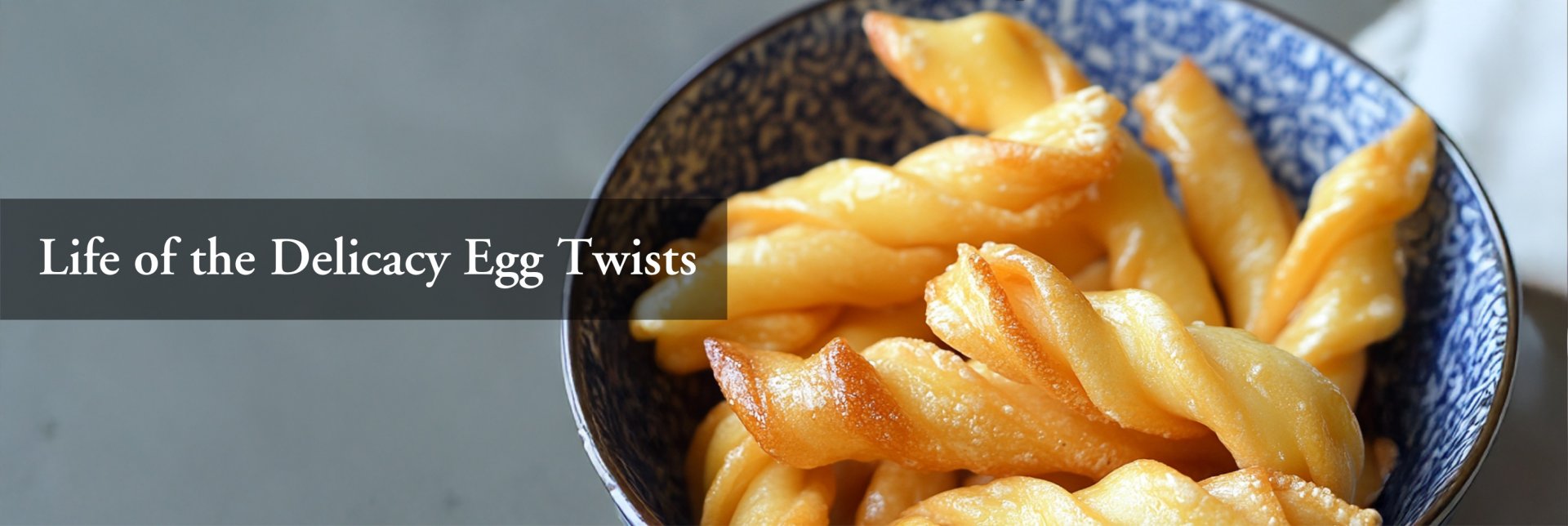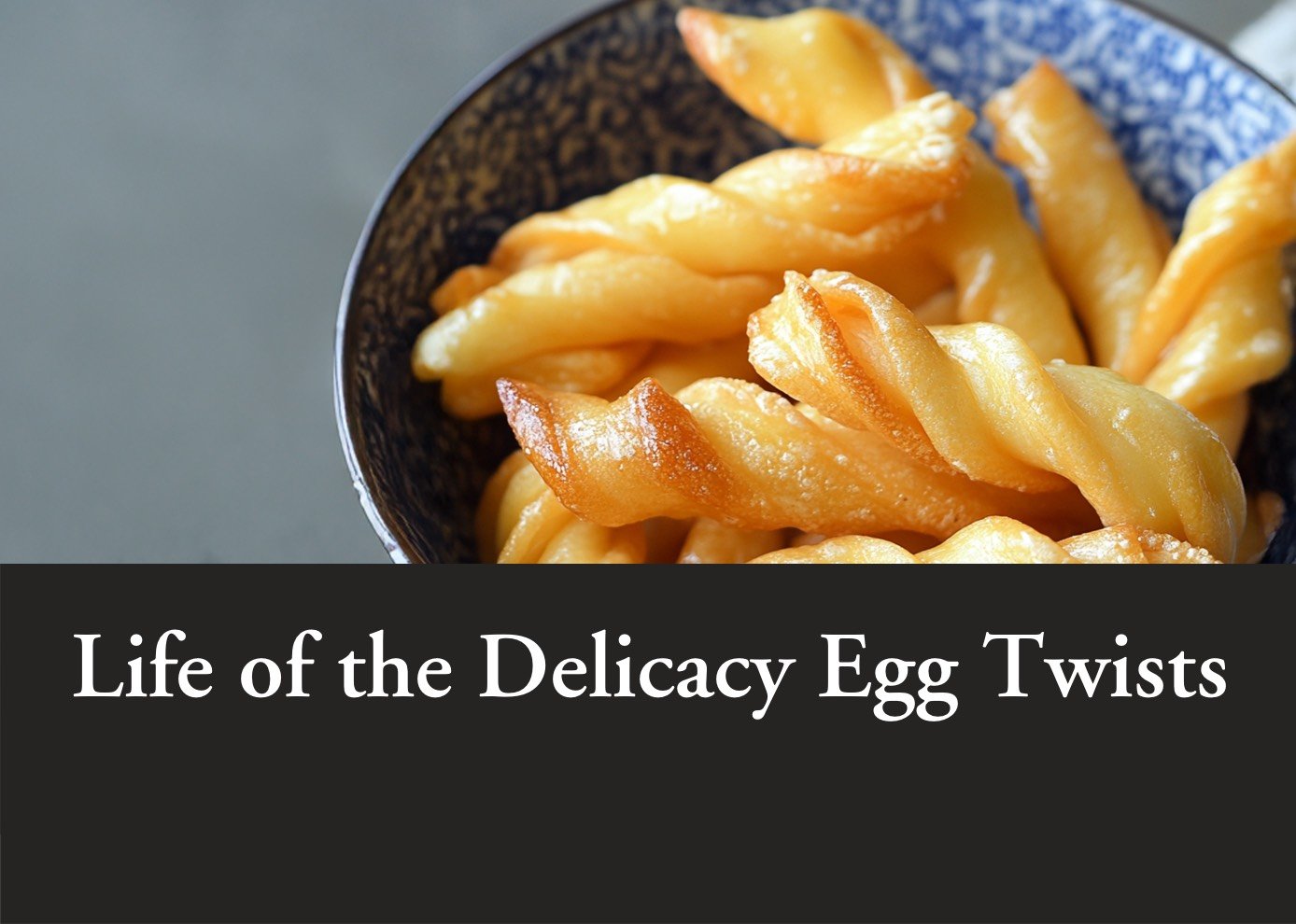Life of the Delicacy Egg Twists
Egg twists, or Dan San (蛋散), is a delicacy of the Cantonese people. Hong Kong people also commonly apply this term to someone who is timid, useless, and unambitious. The reason for this can be attributed to the features of this local delicacy. Egg twists are made by twisting flour, eggs and lard evenly into thin strands, and deep-frying them in a wok. Through cooking like this, egg twists are so crispy that they would melt and break apart in the mouth upon biting, so Cantonese people call it “Dan San” (Literally “egg loose”) and also attribute its looseness and fragility to those low-down, useless nobody.
Egg twists, one of the varieties of flour twists (generally known as Sanzi,饊子), is a traditional Chinese snack with a long history. Flour twist is a fried food made of glutinous rice flour and dough twisted into a ring shape. In ancient times, it was called Han Ju (寒具, cold food), a term originated from the Cold Food Festival (寒食節). It is said that during the Spring and Autumn Period (春秋時期,770 B. C. – 476 or 403 B. C.) , Duke Wen of Jin (晉文公,697 or 671 B.C. – 628 B.C.) was in exile for 19 years. Fortunately, with a group of loyal ministers following him and supporting him, he eventually returned to the State of Jin to take the throne. However, when the Duke rewarded his officials for their merits, he forgot Jie Zhitui (介之推,? – 636 B.C.), who had saved his life. Jie Zhitui, in disappointment with the lord and the state, went into hiding in the mountains with his mother. Knowing they were in the mountains but unable to find them, the Duke ordered people to burn the mountain to force him to appear. To his great surprise, Jie Zhitui refused to surrender and chose to be burned alive with his mother in the forest. Upon regretting, Duke Wen set the Cold Food Festival (one or two days before the Qingming Festival, also known as Tomb-sweeping Festival) to commemorate this loyal minister. During the festival, fire was prohibited for three days and no cooking with fire was allowed. Therefore, people had to prepare some foods that did not require fire-cooking, one of which was flour twists. Because the twists were originally used as a food to eat during the Cold Food Festival, it was called cold food (寒具).

There is no strong evidence to show that the flour twist originated from the legend of Duke Wen of Jin, but what we are sure about is its long history. As early as the Northern Wei Dynasty (北魏,386-535), the classic The Essentials of Agriculture (《齊民要術》 Qimin Yaoshu) mentioned the “cold food” in Volume Nine, stating that “thin ring-shape twists and shredded twists must be made with flour and honey water...to make the snack look good and taste crisp. (細環餅、截餅皆須以蜜調水溲面……令餅美脆)” The book also annotated that “ring-shape twists are also known as cold food. (環餅一名寒具,截餅一名蠍子)” From the records in the classic books more than a thousand years ago, it can be seen that this kind of cold food is shaped like a thin ring, with a sweet and crisp flavor. In addition, the famous poet Su Shi (蘇軾,1037-1101) of Northern Song Dynasty once wrote a poem with the title “Han Ju” (cold food, 寒具), which describes the process of cooking twists with the sentences “gentle hands kneading the dough evenly into a ring, and deep-frying it in clear oil to make the color tender yellow. (縴手搓成玉數尋,碧油煎出嫩黃深)”
Compendium of Materia Medica (《本草綱目》) by Li Shizhen (李時珍1518-1593) in the Ming Dynasty (1368-1644) also recorded in the Volume of Crops that “Han Ju is also known as Sanzi. It is made by mixing glutinous rice flour with a little salt, twisting it into a ring shape, and frying it in oil (寒具即今饊子也。以糯粉和面(麵),入少鹽,牽索紐捻成環釧之形,油煎食之。).” From these ancient texts, it can be seen that Hau Ju (cold food) and Sanzi (flour twists) are actually the same with similar ingredients, appearance, and crisp and fragile texture. Whatever the flavor, salty or sweet, it can be concluded that Dan San (egg twists) is actually the cold food referred to in The Essentials of Agriculture and also Sanzi recorded in Compendium of Materia Medica.

Sanzi has a long history and is widely spread in China. People in different regions make Sanzi using different materials and seasonings according to local products and customs. Therefore, there are salty and sweet ones, big and small ones, which are suitable for different people. Like Sun Wukong (Monkey King, 孫悟空) in Journey to the West (《西遊記》) with multiple identities, Sanzi possesses a variety of flavors. Wheat flour is commonly used in the north while rice flour is the primary ingredient in the south. The fried twists in Hengshui (衡水), Hebei province (河北省), are mostly butterfly-shaped, are lightly salty in Xuzhou (徐州), Jiangsu province (江蘇省), and often go with either horseshoe-shaped pancakes or in congee in Jinan (濟南), Shandong province (山東省). The twists in Hui ethnic group (回族) area are small cylindrical pieces and are flavored with brown sugar, honey, pepper, and red onion peel. In Huai’an, Jiangsu province, the twists are made with brown sugar, honey, sesame seed and other ingredients. The egg twists in Guangdong province, however, are made with flour, eggs, and lard, which are kneaded into a dough, cut into pieces, pressed flat, and then fried in oil.
Finally, why did the Cantonese come up with the unique idea of adding eggs to the twists? It was said that once some families were too poor to buy ingredients such as peanuts, sesame seeds, sugar, etc. to make deep-fried dumplings or sesame balls on the Lunar New Year. When they were at a loss, it occurred that they added eggs and lard to the flour to make them into twists. To their surprise, the twists with eggs were crispy and delicious, with a burst of egg fragrance. Later, the Cantonese delicacy egg twists are gradually accessible to ordinary people.

All articles/videos are prohibited from reproducing without the permission of the copyright holder.




Welcome to leave a message:
Please Sign In/Sign Up as a member and leave a message